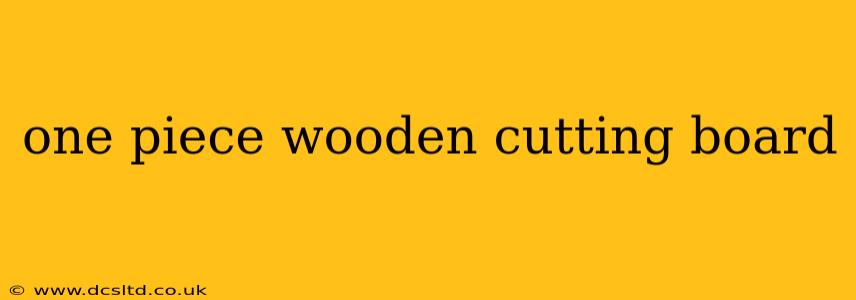Choosing the right cutting board can significantly impact your cooking experience and the longevity of your knives. One-piece wooden cutting boards, known for their beauty, durability, and eco-friendly nature, are a popular choice among home cooks and professional chefs alike. This comprehensive guide will explore everything you need to know about these versatile kitchen essentials.
What Makes a One-Piece Wooden Cutting Board Superior?
Unlike multi-layered or glued boards, a one-piece wooden cutting board is crafted from a single block of wood. This solid construction offers several advantages:
- Superior Durability: A single piece of wood is less prone to warping, cracking, or separating than boards made with multiple pieces glued together. This ensures a longer lifespan for your cutting board.
- Enhanced Hygiene: The dense, solid structure of a one-piece board minimizes the crevices where bacteria can accumulate. While all cutting boards require proper cleaning, one-piece wooden boards offer a naturally less porous surface.
- Aesthetic Appeal: The natural grain and beauty of the wood add a touch of elegance to any kitchen. They are visually appealing and make a statement on your countertop.
- Kind to Knives: Wood is significantly gentler on knife blades than harder surfaces like plastic or glass, reducing the risk of dulling or chipping your knives.
- Eco-Friendly Choice: Many one-piece wooden cutting boards are made from sustainably sourced wood, making them an environmentally conscious option.
What Types of Wood are Best for Cutting Boards?
The type of wood used significantly impacts the board's durability, water resistance, and overall performance. Popular choices include:
- End-Grain Cutting Boards: These boards are made with the wood grain running vertically, creating a surface that's exceptionally gentle on knives. The end-grain also helps to absorb impact, reducing vibrations and protecting your blades. Hardwoods like maple and walnut are commonly used for end-grain boards.
- Edge-Grain Cutting Boards: With the grain running horizontally, these boards are typically more affordable than end-grain boards. They offer good durability and are still easier on knives than plastic. Popular choices include cherry, beech, and teak.
- Hardwoods vs. Softwoods: Hardwoods like maple, cherry, and walnut are more resistant to wear and tear than softwoods like pine. While softwoods are more affordable, they are not ideal for heavy-duty use.
How to Care for Your One-Piece Wooden Cutting Board
Proper care is crucial to prolonging the life of your wooden cutting board. Follow these simple steps:
- Cleaning: Hand wash your cutting board with warm soapy water after each use. Avoid harsh chemicals and abrasive cleaners.
- Drying: Thoroughly dry the board immediately after washing to prevent warping or mildew. Stand it upright to allow air circulation.
- Conditioning: Regularly apply a food-safe mineral oil or cutting board conditioner to keep the wood hydrated and prevent cracking.
- Sanitizing: While wood is naturally antimicrobial, periodic sanitizing is recommended. A solution of diluted bleach (1 tablespoon bleach per 1 gallon of water) can be used, but rinse thoroughly and allow the board to completely dry afterward.
Are One-Piece Wooden Cutting Boards Safe?
Yes, when properly cared for, one-piece wooden cutting boards are safe for food preparation. However, avoid using them for raw meats, especially poultry. Always thoroughly clean and sanitize the board after cutting raw meat to prevent cross-contamination.
How to Choose the Right Size and Shape?
The ideal size and shape of your cutting board will depend on your individual needs and kitchen space. Consider these factors:
- Size: Choose a size that comfortably accommodates the tasks you regularly perform. Larger boards are better for prepping larger meals, while smaller boards are convenient for smaller jobs.
- Shape: Rectangular boards are the most common, but you can also find round, oval, or even uniquely shaped boards. Consider the available space on your counter.
Where Can I Buy a High-Quality One-Piece Wooden Cutting Board?
Many kitchenware stores, both online and brick-and-mortar, offer a wide selection of high-quality one-piece wooden cutting boards. Look for reputable brands that use sustainably sourced wood and employ skilled craftsmanship.
By understanding the benefits, care requirements, and selection process, you can choose the perfect one-piece wooden cutting board to enhance your culinary experience for years to come. Investing in a quality board is an investment in your kitchen and your cooking.
